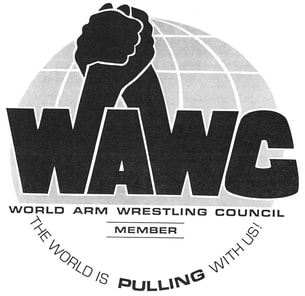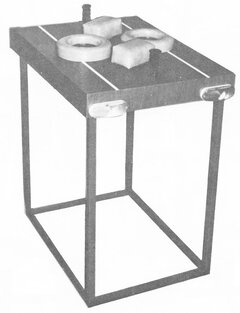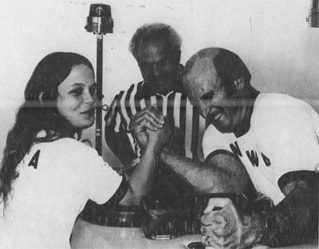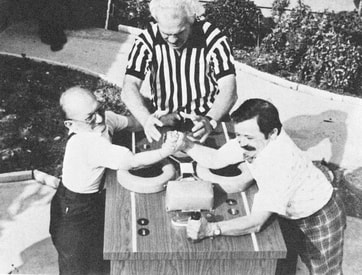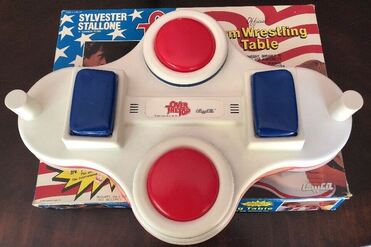The Story of the Jeffrey Family and
the World Arm Wrestling Council
Growing up in upstate New York in the 1930s and 1940s, the Jeffrey brothers loved to armwrestle each other and their friends. When brothers Ernie, Larry, and Bob (there were six in all) moved to the San Gabriel Valley east of Los Angeles in the 1960s they brought their passion with them. All three were in the bricklaying business and pulling on construction sites with any willing opponents was just something they liked to do.
One day in 1968, while working on a job site Bob had one such match with a fellow construction worker. The match was conducted on a rough surface and Bob badly skinned his elbow. That night, he had a dream in which he was armwrestling with his elbow in a sponge, eliminating to possibility for ripped up elbows. Intrigued by the idea, he approached Larry with it, and together they decided to pursue the development of an armwrestling table.
Their initial idea was for an armwrestling game that used magnetic bracelets, padded elbow cups, and touch pads that set off a buzzer to indicate a winner. They called it “Showdown”. Bob and Larry built a prototype, patented their invention, and travelled to Petaluma for the 1969 World’s Wristwrestling Championship with the hope of finding a way to market the game. They even tried to arrange a meeting with Charles Schulz, creator of the Peanuts comic strip, who lived in nearby Sebastopol and who had recently published a story arc in which Snoopy travels to Petaluma for the annual contest. The brothers were interested in exploring the possibility of some type of tie-in. While these efforts didn’t lead to much, it did allow the brothers to make connections, and more generally, get plugged into the organized sport on the west coast.
With limited funds, no interest from toy companies, and few other leads for marketing opportunities, the Jeffrey brothers didn’t do much with their idea in the early 1970s, but a stroke of luck changed everything in 1974. Carroll Rosenbloom, the former owner of the Baltimore Colts NFL football team and new owner of the Los Angeles Rams, had recently moved to Los Angeles and was having renovations done to his home. The Jeffreys were hired to do the brickwork, which led to a conversation with Mr. Rosenbloom during which Bob told him all about their plans to market tables for a new organized sport that had potential for tremendous growth: armwrestling. Bob must have pitched his ideas very well because Mr. Rosenbloom decided to back the Jeffreys with $26,000 to help them get started. And he didn’t just offer financial support, he even provided free advertising space in the Rams programs for an entire season!
Bob and Larry formed the Jeffrey Bros. Equipment Company, and they got to work developing a variety of tables for different needs. In addition to a stand-up table developed for professional competition, there was a table-top version for practice, a portable version, and coin-operated stand-up and sit-down versions. Common elements to all tables were hand pegs, donut-style elbow cups, and pin pads.
While the World Wristwrestling Championship in Petaluma was content to continue using its own tables, a new organization was in the process of being formed in 1974 by businessmen Steve Simons and Marvin Cohen: the World Professional Armwrestling Association (WPAA). Their dream was to make armwrestling a professional sport, with cash prizes, television coverage, and tournaments throughout the country. They of course needed armwrestling tables, and so they reached out to the Jeffrey Brothers. The Jeffreys were understandably excited by the opportunity.
The WPAA inaugural tournament was held in late 1974 and it was a tremendous success. It assembled the largest gathering of armwrestlers up to that point in time: close to 450 in all for this right-arm-only competition. Encouraged by this success, for 1975 a decision was made to hold a handful of regional tournaments on the west coast, leading up to a year-end championship. For the first of these the Jeffreys introduced their new invention: an electronic table with flashing lights that would go off when a pin was detected. Unfortunately, there would occasionally be problems with the lights going on at the wrong time. The technology was subsequently improved, and these tables were used sporadically at WPAA events over the next couple of years. Nevertheless, there were still occasional problems, and many people felt the lights had too much of a carnival feel, so these tables fell out of use completely around 1978.
In 1976, the WPAA expanded across the US, leading to a need for a collapsible table. Not a problem for the Jeffrey Bros. They came up with a version that could easily be broken down and wheeled around to facilitate transportation.
While Bob and Larry focussed on the equipment side of the sport, Ernie’s attention was centered on the organization side. He was very much interested in establishing a standardized set of rules for armwrestling and developing and teaching basic techniques. To this end, he embarked upon writing armwrestling’s first book, which was published in 1977 and titled “Armwrestling: How to Become a Champion”. The book was quite comprehensive and contained (in addition to rules and techniques) information on training, equipment, how to run a contest, history, the major organizations, and some of the sport’s champions. For those who are interested, a few original unsold copies of the book can still be purchased here.
1977 also saw the Jeffrey Brothers form the World Armwrestling Council. At the time, the organization existed more in name only, but its purpose was for various promoters to work together to standardize the sport. Unfortunately, appetite for standardization among the various big promoters of the late 1970s (WWC, WPAA, and AWI) was fairly limited, with each preferring to do whatever they felt was best for their individual promotions. (Interestingly, the International Arm Sports Association, a short-lived organization with a similar aim was formed in 1978 by Texas puller George Koulizos. It too met similar resistance from these organizations.)
When Tony Celeste formed Arm Wrestling International (AWI) in 1977, he only had one company in mind for the tables used in his events: the Jeffrey Bros. Equipment Company. The initial table used is believed to be the same version used by the WPAA. When the National Arm Wrestling Association (NAWA) and the Southern California Arm Wrestling Associations (SCAWA) were formed in the late 1970s, they too turned to the Jeffrey Brothers for their table as well as for general guidance. A smaller table was also developed for dwarves (basically a sit-down table without stools), and Ernie hosted an armwrestling tournament three years in a row at the Little People of America’s national convention between 1978 and 1980.
As the table supplier for the majority of the west coast-based armwrestling organizations of the 1970s, things were going well for the Jeffreys. But things were about to get even more exciting due to a chance encounter. Circa 1979, Bob Jeffrey was doing some brickwork at actress Cloris Leachman’s house in Beverly Hills. Upon leaving her residence one day, he was intercepted by a neighbour who was interested in obtaining a quote for some brickwork at his place. Bob didn’t have his bricklaying business card on him, so he gave him a Jeffrey Bros. business card instead, which included his phone number. Immediately the neighbour started asking questions about armwrestling and was clearly intrigued by the sport. It just so happens that the neighbour happened to be actor and screenwriter Gary Conway. Mr. Conway had already written a script for a movie to be called “The American Dream” about a truck driver who was attempting to reconnect with his son after being absent from his life for several years. He was getting ready to start shopping his script around town and planned on being the star of the movie. Upon learning about armwrestling, he decided to rewrite the script, turning the father into a professional armwrestler who was getting ready to compete in the world championships (in addition to reconnecting with his son). He even retitled the script to “Over the Top”, which was the name of a technique described in Ernie’s book.
The idea for the film started to gain momentum by the end of 1979 and plans were made to host a large tournament for realistic footage. The tournament would be held at the Dunes Hotel in Las Vegas on December 8th and would have large cash prizes. Many of the sport’s top stars were set to attend… but sponsorship fell through within a week or two of the event date. There would be no huge prizes, there would be no film cameras, BUT there would be a tournament, thanks to Larry Seigfried of the southern California-based NAWA. With only a few days to work with, he was able to arrange for a tournament to be held as scheduled at the same location. He called it the US Open Arm Wrestling Championship, and was still able to offer cash prizes, though significantly smaller than initially announced. Nevertheless, several top pullers attended, including Cleve Dean, Johnny Walker, and Clay Rosencrans, who won their respective classes.
The Jeffrey Brothers had been particularly excited by Over the Top because they had an agreement with Gary where they would serve as technical advisors and share merchandising rights for the movie. But with sponsorship falling through, momentum for getting Over the Top to the big screen was lost in the early 1980s, and Gary eventually sold the script to Canon Films. Menahem Golem, the head of the studio, liked the idea of an armwrestling movie but was not interested in having Mr. Conway play the starring role. He wanted someone else: Sylvester Stallone. It took a significant amount of convincing and several script re-writes, but eventually Sylvester agreed to make the movie.
Another change that occurred once Canon purchased the film rights was that the Jeffrey Brothers were not brought on in an official capacity. While their tables would be used in the film, they were not enlisted as technical advisors, nor were they granted rights to use the “Over the Top” title to market any of their products. This eventually caused some bitterness, especially considering the term “over the top” was the name of an armwrestling technique first described by Ernie in his 1977 book. Following the release of the film, Bob and Larry filed a lawsuit against Canon Films for reneging on the original agreement made with Gary Conway. The outcome of the case is not known but is believed to have been settled.
Unfortunately, Over the Top was considered a box office disappointment when it was released in February 1987. Sales for the Over the Top toy line, which included a children’s version of the Jeffrey Bros.’ “Little Jeff” table, were also dismal. However, given the film raised public awareness of the sport, Bob and Larry thought it would be a good time to take another look at reviving the World Arm Wrestling Council. Perhaps now there would be more interest among promoters to work together to further the sport. However, by this time Ernie had passed away and Bob and Larry were already in their 60s, so they asked Alan (Bob’s son who was in his early 30s) if he would be interested in taking the reigns. He had been exposed to the sport his entire life, and while he wasn’t a competitive puller, he knew a lot about armwrestling and had a clear vision of where he wanted the sport to go – ultimately to the Olympics.
Alan was able to leverage the knowledge and experience of some of southern California’s top armwrestlers. The Jeffrey family had been keeping regular contact with pullers like John Woolsey, Virgil Arciero, Ron Bennett, and Ken Stollmeyer since the 1970s. They shared their opinions on various aspects of the sport, including table design and dimensions, rules, referee certification requirements, etc. Alan also competed in a few amateur events to get a feel for the tournament experience from an athlete’s perspective and to better be able to identify potential issues with any rules.
Alan was aware of the Pennsylvania-based World Arm Wrestling Federation (WAWF), and that it had similar aims as the WAWC, but he felt that the WAWF was making little progress to advance the sport. He was also of the opinion that stand-up armwrestling had a better chance of making it to the Olympics than the sit-down version that was the dominant style of the WAWF at the international level.
Much of 1987 and 1988 was spent trying to make connections, building a network of like-minded individuals, and figuring out the requirements for getting armwrestling into the Olympics. This was all done in the pre-Internet days, which meant Alan spent countless hours in the library tracking down addresses and phone numbers, and writing letters to and/or phoning virtually every national Olympic committee in the world. Some of his early successes came when he secured face-to-face meetings with members of the US Olympic Committee in Orlando and Dallas. During these meetings he was able to present the sport and obtain a considerable amount of information on what needed to be done to have chance at Olympic recognition.
One of the main requirements was for each country to have a national sanctioning body for the sport. The body would host a national championship which would serve to qualify athletes for the world championship. For the US he turned to California promoter Randy Sampias, who established the United States Arm Wrestling Association (USAWA) for this purpose in 1988.
In 1988 the WAWC got a foothold on the east coast when puller and gym owner MG Harmon called Alan out of the blue expressing interest in being involved with the organization. He invited Alan to Whyteville, Virginia, to talk about his ideas for the sport. Alan saw potential for a WAWC base in the east to compliment the work being done out west, and MG came on as the Vice President of the USAWA.
Many of the decisions made by the WAWC were done with the target of getting armwrestling into the 1996 Summer Olympics as a demonstration sport. By the end of the 1980s, it was looking very likely that Atlanta would be selected to host the Games, and it was thought that this would be a great opportunity to showcase an organized sport that first developed in America. One of the important elements was that it needed to be clear that the focus of the WAWC was on the amateur side of the sport. While the Olympics has changed its stance on allowing professional athletes to compete in recent years, in the 1980s pros could not compete in the Games.
By mid-1988 the WAWC had grown to the point where it had nine nation members across four continents: Argentina, Austria, England, Israel, Netherlands, Scotland, Switzerland, United States, West Germany. Alan felt the WAWC was ready to reach out to the International Olympic Committee. A letter was sent to the IOC and to Alan’s surprise and delight, the WAWC was invited to Lausanne, Switzerland to present the sport. As President of the WAWC, Alan attended this meeting on July 20, 1988 with WAWC Vice President Clive Myers of England, as well as representatives from Scotland, the Netherlands, and Switzerland. The IOC was impressed by the presentation, and commended the WAWC for establishing clear rules, unified conditions for competition and a high standard of qualified referees. It also stressed the importance of taking steps to move away from the traditional bar-room image of the sport. The next day, the IOC accepted a formal application for the recognition of the WAWC as the sport’s sole International Federation, which was the first step towards armwrestling one day becoming an Olympic event.
The USAWA held its first Amateur National Championship on November 25 and 26, 1988 in Daytona Beach, Florida, at which the top six finishers in each class would qualify for the 1988/1989 WAWC World Amateur Championship to be held on January 20 and 21, 1989 at the same location. Approximately 100 competitors from eight nations attended this inaugural world event.
The WAWC continued to add member countries over the following year, which resulted in a slightly larger turnout for the 1990 Worlds, held on May 19 in Whyteville. This time, 12 nations attended and 127 pullers entered the competition.
Unfortunately, by the early 1990s Alan was starting to lose motivation. While additional countries were joining the WAWC, the magic number of 35 (the minimum number required to be considered for Olympic status) still seemed far away. And within the US, the lack of cooperation among the various promoters was disheartening: most seemed content to just keep doing their own thing, stifling the USAWA’s growth. There just wasn’t enough support for the type of changes required to make the sport more professional (i.e. in a way that was in line with Olympic standards). Also, by this time the IOC had been contacted by the WAWF to be recognized as armwrestling’s international governing body. The IOC is very clear on the need for a single international federation, and it was also clear that the WAWF would be continuing its pursuit. Because of all this, in 1992 Alan decided to bow out of the sport.
A final WAWC World Championship was held in Tokyo, Japan, in December 1992. It proved to be the biggest one up to that time, with 15 nations represented. Despite this, without a clear path forward for the WAWC to get armwrestling into the Olympics, the organization ceased operations in 1993.
The Jeffrey family’s 25-year contribution to the organized sport of armwrestling cannot be understated. The Jeffreys were involved in virtually all aspects of the sport and can be credited with many firsts: the first electronic armwrestling table, the first armwrestling book, the first armwrestling organization to meet with the IOC, etc. It’s fair to assume that the WAWC likely accelerated the WAWF’s efforts to grow the sport internationally. And finally, it’s hard to imagine how the sport would have evolved without some of the Jeffrey Brothers’ chance meetings. How big would armwrestling be had the idea for Over the Top never materialized?
Researched and Written by Eric Roussin
Originally published in January 2021
Special thanks to Alan Jeffrey for granting an interview. Without his input this article would not have been possible. (And thanks to Lori Cole for making the connection!)
WAWC Results
Few results from the WAWC World Championships have surfaced, however the following pullers are known to have won titles:
1988/1989 WAWC World Championships
January 20-21, 1989 – Daytona Beach, FL
Men’s Right 145 lbs
1. Todd Kearney
Men’s Right 185 lbs
1. Bryan Croft
1990 WAWC World Championships
May 19, 1990 – Whyteville, VA
Class Champions (weights unknown)
Rick Laton
Junior Hostler
Bryan Croft
David Morocco
Kevin Johns
Gerald Beatty
Gordon Griffiths
Bobbie Rogers
Wendie Rogers
Achim Edel (Germany)
Katsuo Namba (Japan)
Helen Van Arendonk (Netherlands)
1992 WAWC World Championships
December 1992 – Tokyo, Japan
Men’s Right 145 lbs
1. Chad Silvers
Men’s Right 185 lbs
1. Bryan Croft
Men’s Right 211+ lbs
1. Gerald Beatty
Men’s Left 210 lbs
1. Dickie Spiroff
England’s Rod Lenette also won WAWC world titles with both arms, but the class and year are unclear.
